The 16th UK series of Who Do You Think You Are? has some really fascinating stories to tell. One which many of us will enjoy is that of the Oscar-winning actor Kate Winslet’s very personal journey into her family history. Kate is looking into both her father’s and late mother’s ancestry in this episode.
Kate Elizabeth Winslet OBE was born in Reading in 1975 and in the programme Kate tells a family story about her own birth. The tale is that her Mum (Sally) was cooking Sunday lunch when she went into labour. Living not far from the local maternity hospital, Sally headed there, gave birth and then returned home with Baby Kate in time to serve the crumble…
Which really sums up my mum, she was a brilliant multi-tasker…and could just do it all”.
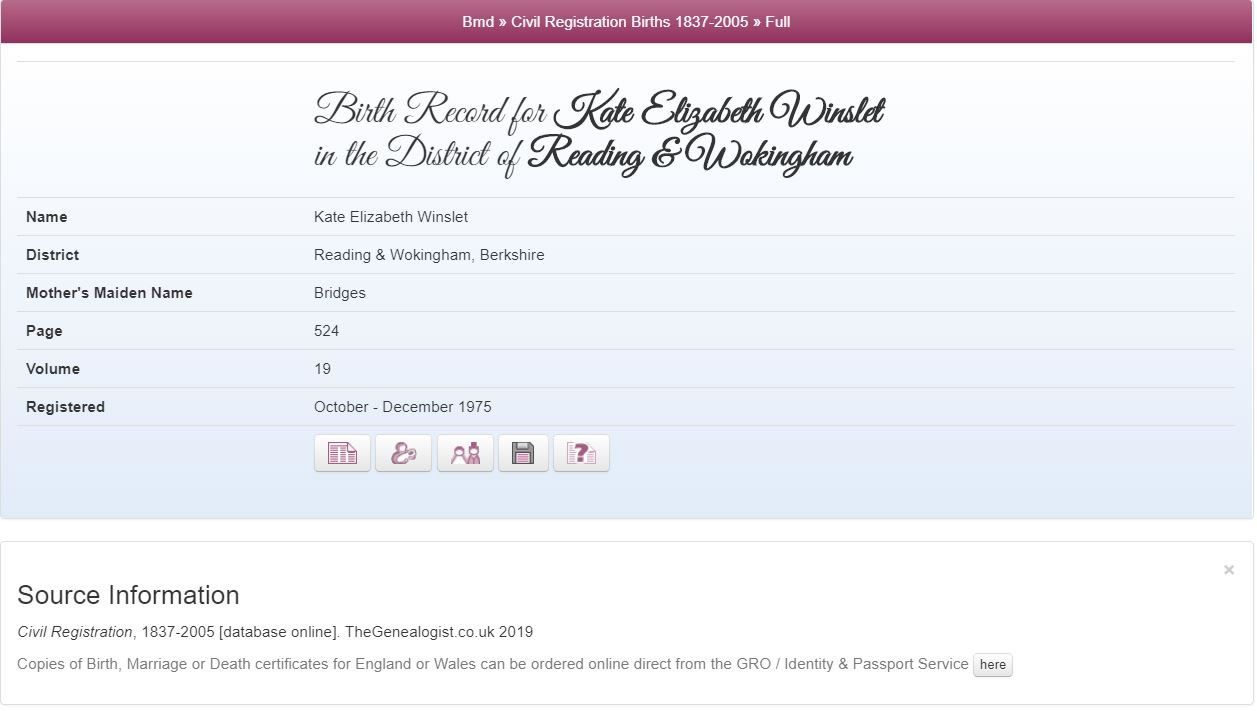
Kate explains to the viewers of Who Do You Think You Are? that her parents had struggled for money whilst she was growing up but despite this it was a very happy family. Roger Winslet, her father, worked as an actor but as finances were tough he also took whatever jobs he could including one job, that Kate reveals, was for the National Trust. The main attraction was that it came with a 16-seater bus that he could use to transport his large family around, the Winslets not having transport of their own.
On her father’s side of the family, Kate remembers “lots of pubs, lots of booze, clearly, lots of actors, but much more than that I don’t really know.”
Kate becomes emotional when remembering her mum, Sally, who died of ovarian cancer nearly two years ago. Kate says of her – “if she was here now she would say ‘come on, shoulders back, sit up straight, don’t swear’…we all miss her terribly.”
The actor is keen to find out more about where she comes from on both sides of her family and not surprisingly the genealogy programme does just that. She has memories that as a child there were rumours of a possible Scandinavian connection in her mum’s family:
And people would say when we were younger, ‘God you look like a group of Scandinavian people’… That would be good!
Kate’s Maternal Line
The investigation kicks off with a letter to Kate from her Uncle Mark, who is Sally’s younger brother. Mark tells of his mum’s great aunt Lily who, he was always told, was Swedish.
Lily’s death certificate shows that she was buried in 1964 and lists the Swedish Church in Marylebone, London. Keen to find out more Kate pays it a visit as she assumed that this would be the final resting place of her maternal ancestor. The church was built in 1911 to provide a place of worship for London’s Swedish community and viewers of the BBC programme follow Kate inside where she meets a historian who has more information for her. Lily (or Lillian), it turns out, was not buried at the church, as it has no burial ground, but at Brookwood Cemetery, near Woking, where there was an area for Swedish Church members. As well as Lilly the historian has found that Kate’s great-great grandfather, Alfred Johanson Lidman (who was Lily’s brother) was also buried there in 1922.
A record from the Swedish church shows that Alfred had been a tailor by trade, and that he was born on the 21st April 1857 in the Swedish parish of Halland. By the time that he got married in May 1884 he had made the move to England. Kate is over the moon to find her ancestor was completely Swedish.
Oh my goodness me! He was 100% Swedish – this is just brilliant!

From several census records on TheGenealogist we can find him living in Great Pulteney Street where he worked as a Tailor. At the time that Alfred came to London it was the largest city in the world and sustained over 50,000 tailors many of whom, like Alfred, were immigrants to Britain. Kate and the historian consult a Booth map, which used a colour-coding system to record poverty and wealth in London. By using these maps we can see that the road that Alfred and his family were living on in 1891 Great Pulteney Street in Soho was coloured red/pink on Booth’s map and this meant it was middle class.

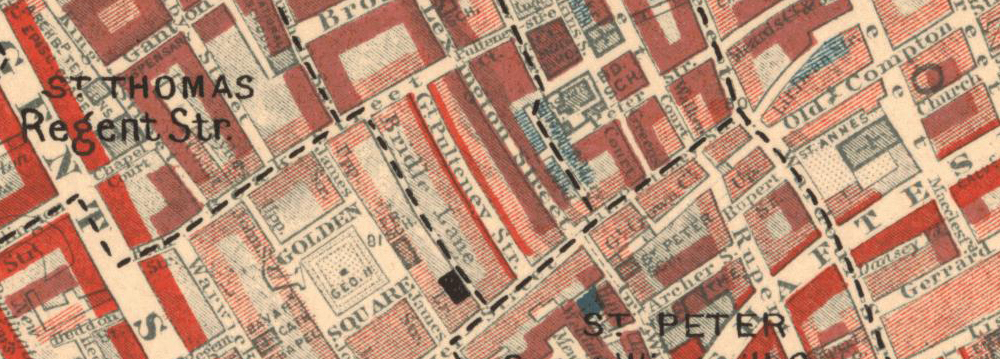
Alfred, who had migrated from Sweden as a teenager, was clearly successful and doing well on the evidence of where he was living.
I like this man – I like this man a lot
To trace back further in this branch of her family Kate travels to Halland, in Southern Sweden. This is the region from which her 2x great-grandfather Alfred Lidman had originated. At a large country estate, with a small palace called Sperlingsholm that was built in 1820, Kate meets a local genealogist. An 1826 birth record that she is shown lists a ‘Johan Christian’ being born on the estate in 1826. This was the son of a stable groom who was employed at Sperlingsholm and the expert explains to Kate about the Swedish naming pattern: Johanson being the son of Johan. This points to Johan Christian being the father of Alfred Johanson Lidman, and therefore her 3x great-grandfather. These Swedish naming patterns would make Kate’s name ‘Kate Rogersdotter’ which Kate finds sounds strange!
![Sperlingsholm Sweden where Anders Jonsson was a groom. Photo by Jorchr [CC BY-SA 3.0 (https://creativecommons.org/licenses/by-sa/3.0)]](/images/featured-articles/2019/who-do-you-think-you-are/01156/wdytya2019-winslet4.jpg)
Johan was one of five children who were born to the stable groom Anders Jonsson and his wife, Anna Christina Eriksdotter Kate’s 4x great-grandparents. But the employees on the estate were tied to it by the system of payment. Visiting the site of the stable block where her direct ancestor Anders would have once worked, Kate is able to handle an example of the currency used on the Sperlingsholm estate a system of tokens were used to be spent only at the on-site shop for food. This made sure that any wages that the workers earnt on the estate stayed within it, being spent on food produced by the estate itself. Kate immediately understands that this kind of arrangement must have meant that a man like Anders, with a young family to support, must have felt trapped there being tied to the estate and unable to save any money or to move on to another job.
Kate is shown a death record that backs up this hypothesis. In 1831 Anders and Anna’s son, Gustaf, died aged just 3 months old. The cause of death was recorded in Swedish as ‘twinsoot’ translated this means malnutrition. The 1830s were bad for Sweden when it suffered from a series of devastating crop failures that lead to its citizens enduring starvation and hardship. A letter from the time reveals that just five months after the death of his son, in the midst of winter and in desperation to put food into the mouths of his remaining children, Anders was arrested. He and another man were charged with stealing 3-4 barrels of potatoes from local farmers.
Good on you Anders, I would have stolen the potatoes as well”.
Anders, however, was imprisoned in Halmstad Castle that had been built in 1621 as a royal palace. Kate travels there next and meets another historian who is able to tell her what happened to her 4x great grandfather.
Access Over a Billion Records
Try a four-month Diamond subscription and we’ll apply a lifetime discount making it just £44.95 (standard price £64.95). You’ll gain access to all of our exclusive record collections and unique search tools (Along with Censuses, BMDs, Wills and more), providing you with the best resources online to discover your family history story.
We’ll also give you a free 12-month subscription to Discover Your Ancestors online magazine (worth £24.99), so you can read more great Family History research articles like this!
The prison block, where Anders was held, has since been demolished but a poignant relic survives. Anders had been a stable groom and it is an image of a horse and rider, that an unidentified prisoner had engraved on a wooden panel of a cell wall, that has been preserved and is on display to this day.
From the account of her 4x great-grandfather’s trial Kate reads:“‘Anders Jonsson who has a weak body constitution and a more round than oblong face, a pointed nose and dark hair…’ I’m going to cry now… ‘dark hair and dark eyebrows, stated that he is 42 years old and has never been suspected of any crime.’“
Kate notes that at 42 he was just a year younger than she is and she believes he had good reason to steal the potatoes and thinks that it was a one off crime. Anders, however, it turns out had also been accused of another theft with the same accomplice – this time it was a beehive they had stolen, for the honey inside. She reads on. Anders was sentenced to be whipped – two rounds of 35 strokes. The historian reveals, however, that Anders would probably have never received his sentence because he died in prison. Kate reads his death record and becomes upset for her ancestor – “I’m going to cry again now”. It states that Anders died in 1832 of “nerve fever,“ which was probably typhus, caught while in prison.
I’m angry now…
His wife Kate’s 4x great-grandmother Anna would have been left with four children, including Kate’s 3x great-grandfather Johan. Kate realises that young Johan would have been the same age then as Kate’s youngest child, Bear was when she filmed the programme. This stikes home to her as she tries to think what it would be like for Bear to lose his father.
The investigation then tries to discover what became of Johan. Happily, the first record she is shown is that of his marriage to Anna Johansdotter. From the document it is revealed that at the time of his wedding Johan was a “Rotebatsman”: a rating in the Swedish Navy. The landowners had to provide men for the military and the job came with a small salary plus a croft, or small cottage, where he could live with his family. The records also tell us that the nickname Johan was known by in the navy was “Gokunge” a ‘young cuckoo’!
With the historian, Kate then visits a similar croft to that which her 3x great-grandparents had. It is a tiny but beautiful building and in a place like this, Anna and Johan had three children. The upbeat mood changes, however, when Kate recognises a Swedish word that she has seen before. She has been handed another death record. It records that Anna and Johan’s first-born, a daughter, died after only 17 days. Then their second child, Edvard, died of smallpox at seven months.
This sadness is terrible. She must have become terrified of losing more. How does a woman like that carry on?
In 1857, Anna gives birth to another boy Kate’s great-great-grandfather Alfred. But the story has yet to turn the corner as the family endured yet more hardship: Johan was discharged from the navy for “embezzling several of the Crown’s belongings,“ and for this he received the punishment of being flogged 40 times. Kate learns that this was a hard time in the country as the years of famine continued to make life desperately hard for poor Swedish families like hers. Tens of thousands of families chose the only option they could see and that was to leave Sweden and start new lives elsewhere. After his crime and lashing, Johan turned to tailoring a trade that he passed on to his son Alfred, who Kate knows left Sweden for England and was able to make a successful life for himself and his family near Savile Row.
It really is a story of survival of people who fought and carried on in the face of incredible tragedy.
Paternal line
Turning now to her father’s branch of the family, Kate goes back to Reading, where she was born and grew up. Before heading over to her Dad’s house, in the TV programme she stops by the house where she lived until she was 16 and remembers how the family of 6 squeezed in to the rented home whose windows rattled every time a double decker bus drove past. The actress changes her accent as she says “I ain’t posh mate!”
At Roger’s house, Kate looks through family photographs with her dad, including a striking period posed one of her grandmother Blanche. A photograph that she had never seen before. Roger also has the marriage certificate of his grandparents (and Kate’s great-grandparents) and passes it to Kate. The certificate gives their names George Robert Sims and Florence Edith Bick and records that when they married he was a barman and she was a barmaid. From the document we can see that their address at the time was the White Lion on Islington High Street, which we can find by using TheGenealogist’s Map Explorer. It has long closed as a pub and by sliding the opacity control on the Map Explorer, to allow the fading in of the modern map from beneath, we can see that the building is now the premises of one of the big four banks.
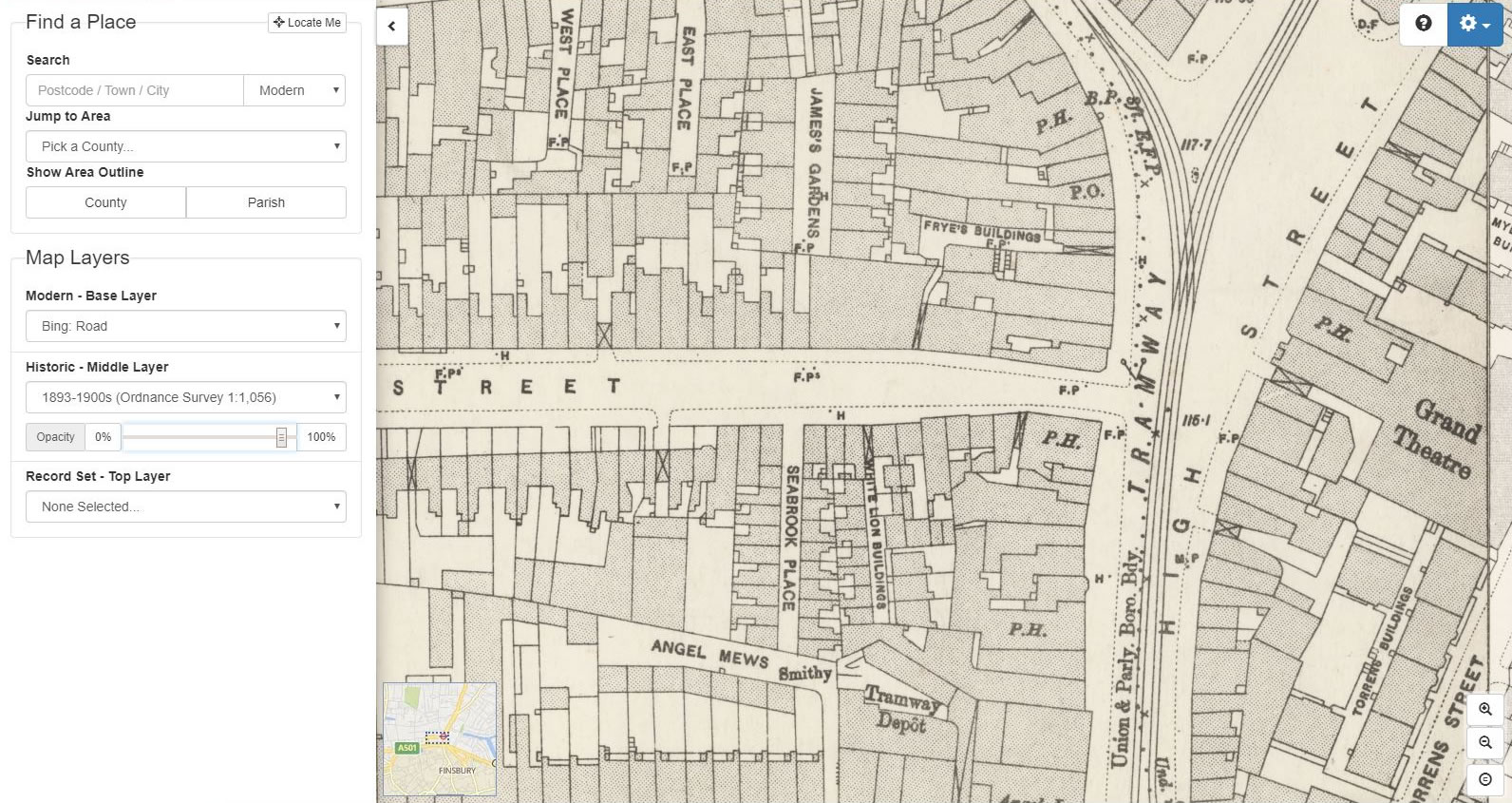

This connection of her family to pubs is just what Kate imagined she would find. But looking closely at the marriage certificate, Kate then reads that Florence’s father, Thomas Bick (Kate’s 2x great-grandfather) was recorded on the document to be of ‘independent means’. This is unexpected, and Roger can’t explain it so Kate sets off to find out what this could mean.
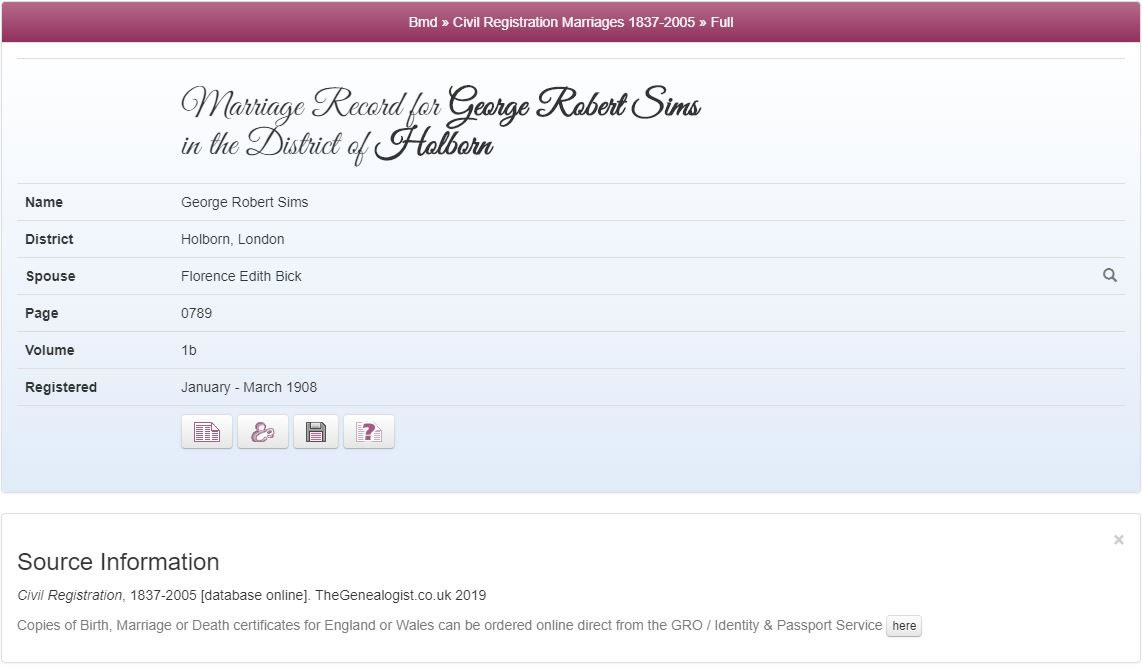
At a café the producers of Who Do You Think You Are? have set up a meeting between Kate and a professional genealogist who has a family tree for her. This shows that Thomas Bick had been a soldier and a Horseman, and therefore his ‘independent means’ was not an indication of great wealth, but more of a reference to him being in receipt of an army pension. Searching TheGenealogist’s records finds the 1891 census in which Kate’s grandmother, Florence aged 11, is listed with her sisters, mother Marian and father Thomas Bick. Thomas, at this time, has been recorded as a “Horse Foreman” or Groom and we see that he was born in Barnwood in Gloucester while Marion was a London girl. Florence, meanwhile, had been born in Chatham in Kent, probably while her father was serving in the military.

The tree that the genealogist has produced reveals more about the family showing that Florence’s mother, Marian Colquhoun, was one of eleven siblings! Kate is stopped in her tracks by this revelation. The genealogist’s work has traced Marian’s parents to be William Colquhoun and Eliza O’Brien Kate’s 3x great-grandparents. William, it turns out, was a soldier in the Grenadier Guards a prestigious regiment in the Household Division and responsible for guarding Buckingham Palace and Windsor Castle.
Access Over a Billion Records
Subscribe to our newsletter, filled with more captivating articles, expert tips, and special offers.
Well I hope he was good at his job because he had 11 children to support and a young wife – a lot of mouths to feed
At Wellington Barracks, the home of the Grenadier Guards, Kate watches the regimental band parade as they lead the troops out for the traditional ‘changing of the guard’ ceremony.
Wondering if her 3 x great-grandfather had been a military musician, Kate meets a historian who is able to show her William’s service record. This reveals that William had been a Drummer in the regiment. One of the surprises in the record is the note that he was “Under Age” at the beginning of his service. The military historian explains that William was in fact a drummer boy, as he was only 11 years old when he enlisted in the army. Kate finds this incredible:
How is that even allowed?
The historian explains that because William’s father was also a soldier, it was not unusual that his son had enlisted at a young age and that it would have meant that William would not only learn to drum but that he would have been taught to read and write so getting the chance to better himself. At a time when education for the less well off was hard to come by, the British Army would be a sensible choice. William served as a drummer in the elite Grenadier Guards for almost 20 years, until he got his break when he transferred to the 30th Foot regiment where he was promoted to Drum Major. Drum Majors, Kate learns, were performers who marched in front of the band leading the regiment during marches, tossing their canes into the air and commanding the parade. Kate is thrilled to hear that her ancestor took part at the front of the regiment providing such flamboyant entertainment, and also that he was able to make something of his life through commitment and his musical talent.
Drummers had an important practical role to play in the daily life of the regiment by playing standardized beats which kept soldiers on schedule throughout the day drumming in the morning when the men had to rise, eat, work and sleep. In the Guard’s chapel, London Kate is given a lesson on the drum by the historian and then she tries her own hand at one of the standard drumming rhythms.
Kate is not so happy to learn about one of the other roles that drummers also played in the British Army. Because they had strong arms and good rhythm they were given the task of carrying out any sentences of corporal punishment on men in their regiments specifically, using the infamous ‘cat o’ nine tails’ whip to flog the bare backs of those being disciplined. A soldier could be whipped for breaches of discipline such as desertion, theft or drunkenness. Knowing that her Swedish ancestor had been on the receiving end of the whip, Kate finds it difficult to hear that as a drummer her British ancestor William would have had to carry out these punishments, and then as a Drum Major he would’ve had to supervise them. The flogging would be in public, conducted with military ceremony, as the whole regiment would be gathered on parade to witness the administering of the punishment. The military historian explains that William had no choice in the matter it was part of life in the army and he would be carrying out his orders. It was flog or be flogged.
By 1839, William’s life in the military came to an end because he was suffering from chronic rheumatism and unable to do his job. Discharged from the army after 30 years Kate wonders what a man in his early 40s with eleven children would go on to do.
Researching on TheGenealogist for the 1841 census catches up with the forty something year old and his much younger wife living in Holland Street, Westminster, London. In this census his occupation is given simply as an Army Pensioner.
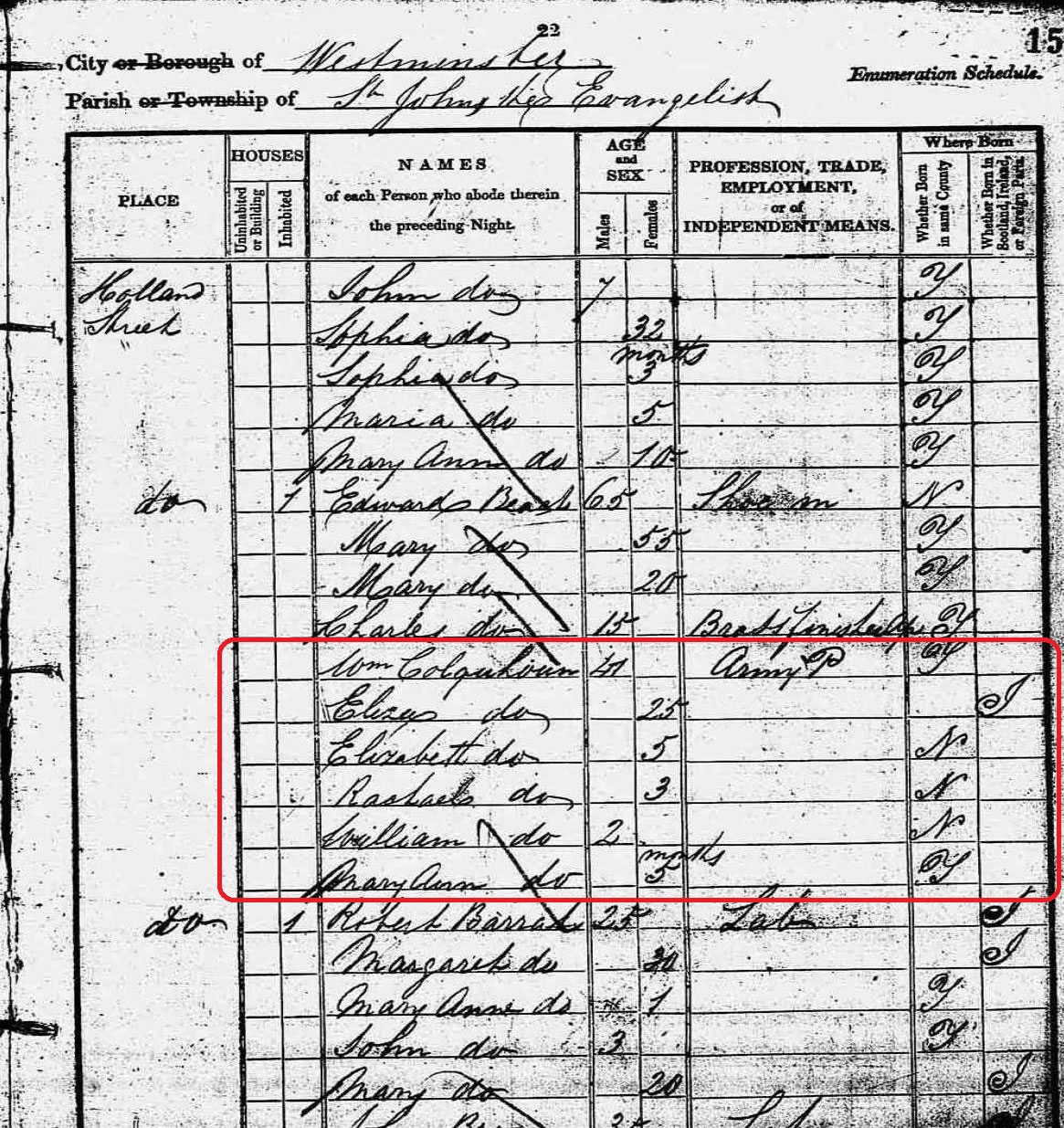
William didn’t stay in London, although his family did. He had taken on a new job and this meant an eventual move to Devon for him. Searching forward to the next census in 1851 reveals that William had become one of the Principal Warders at Dartmoor prison.
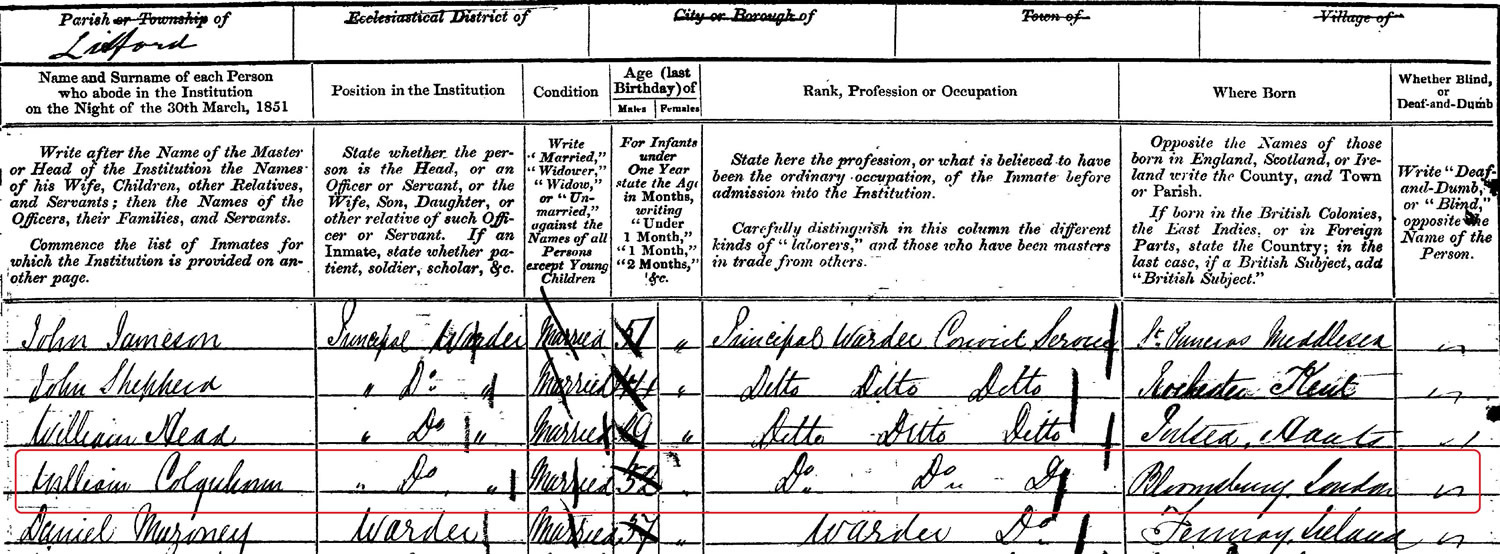
The programme follows Kate as she takes the train to Dartmoor. She expresses feeling conflicted about her ancestor a man who she admires for working his way up from nothing, but also someone who witnessed and meted out severe military punishment.
She is heartened to hear that when her 3x great-grandfather was a warder at Dartmoor, the prison was going through a period of change. Entering the modern day prison, Kate meets a historian who describes the new and relatively progressive approach that the prison was taking in the mid-19th century period when William was a prison officer. Dartmoor was focusing on rehabilitation rather than transportation and punishment of the convicts. Men were being taught trades, and there was an education programme that included subjects like maths, history and geography. Kate is heartened to read a newspaper article from 1851 that describes a tour of the prison, given by Kate’s 3x great-grandfather William. The Governor had assigned Principal Warder William Colquhoun to take the journalist around the institution and the correspondent was impressed enough by his guide to describe William as an ‘intelligent officer’ with ‘the strict disciplinary habits of an old military man’.

William, sadly, died in Devon 1856 at the age of only fifty six. The TV researchers have identified that two of his children joined the army carrying on the family tradition like their father, and his father before him.
Prior to leaving Devon, Kate pays a visit to the Ford Park Cemetery in Plymouth where William is buried. While she is able to see the beautiful graveyard, she discovers that her ancestor is buried in common ground and so had no headstone as a memorial.
The research into Kate Winslet’s family has provided a rollercoaster of emotions for her to cope with ranging from elation, pride, anger and sadness. It has revealed that the award winning actress has some fascinating forebears in her family tree that she is rightly very proud of.

Sources:
Press Information from IJPR on behalf of the programme makers Wall to Wall Media Ltd
Extra research and record images from TheGenealogist.co.uk
BBC/Wall to Wall Ltd Images
Wiki Commons






